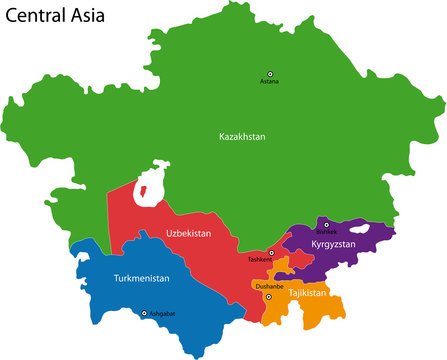The United States’ ambitious scheme to reshape the fractured economic landscape of Central Asia is already racking up some impressive wins right out of the gates. Their newly minted ‘B5+1’ initiative, designed to tear down the trade barriers shackling the former Soviet ‘Stans’ and foster a unified regional market, is hitting major milestones surprisingly fast.
You Can Also Read: What US Moves Convinced India on Laptop Rules?
The B5+1 initiative, functioning within the parameters of the established C5+1 collaboration, will place a primary focus on bolstering economic security. This will be achieved through the promotion of regional economic integration, the enactment of reforms, the facilitation of public-private dialogue, the stimulation of innovation, and the attraction of foreign investment to member nations.
In a bid to promote economic cooperation, Kazakhstan, Kyrgyzstan, Tajikistan, Turkmenistan, Uzbekistan, and the United States (US) unveiled the B5+1 business platform on November 16, 2023, as announced by the U.S. State Department’s Bureau of South and Central Asian Affairs (SCA).
A Yearly Mega-Summit is Now Locked In
One of the core initial objectives was institutionalizing an annual forum where the heavy-hitters from both private and public sectors across all five nations – Kazakhstan, Kyrgyzstan, Tajikistan, Turkmenistan, and Uzbekistan – could hash out ways to better integrate their economies. Well, that box is officially ticked in permanent marker.
The pioneering B5+1 summit just wrapped up with a bang in Almaty, Kazakhstan – and regional enthusiasm is absolutely skyrocketing. In fact, Kyrgyzstan and Uzbekistan are already fiercely battling it out to host next year’s edition on their home turfs. The competitive juices are clearly flowing.
But perhaps more crucially, the corporate titans who attended have loud and clear signaled they’re fully strapped in for this ride. The private sector big dogs issued a joint manifesto outlining their intent to coordinate improving trade, transport, and investment facilitation across borders by harmonizing tangled regulations.
They’re aiming to finally extend economic integration beyond just the energy, mining, and extractive industries that have hoarded the spotlight of Western investors until now. Five fresh sectors are being prioritized – trade/logistics, agribusiness, e-commerce, tourism, and renewable energy.
And we’re not just talking lofty rhetoric here. Specific action plans are being mapped, like developing unified, digitized documentation for cross-border trucking to cut through customs headaches. Other concrete proposals include scrapping visa requirements for import/export drivers and implementing a Europe-style ‘Schengen’ tourist visa for seamless regional travel.
The Bigger Prize Coming in Focus
But the really mouthwatering prospect being dangled is the following: establishing a fully unified, borderless single market bound together by a region-wide chamber of commerce banging the drum for integration. A smooth, one-stop arbitration system would efficiently referee any commercial beefs.

According to their official manifesto, these corporate hitters envision Central Asia shedding its status as a mere “transit zone” along global trade routes. They foresee it blossoming into a hotbed destination for investment in its own right – one playing by transparent, evenly-applied rules enabling win-win deals all around. The U.S. State Department wasted zero time commending the summit’s progress and reaffirming Uncle Sam’s role as the committed facilitator fostering this whole process from the ground up.
Navigating a Minefield of Obstacles
To be realistic, this path to integration is absolutely littered with daunting potholes and potential roadblocks. Arguably the biggest is whether the Central Asian Governments can actually willfully cede any meaningful power to the private sector.
Sure, their proxies are talking the talk about supporting businesses shaping policies and regulations. But honestly empowering commerce over rigid state control is a prospect many of these ex-Soviet republics might find difficult. We also cannot gloss over the private sector’s own capabilities here – they’re relatively greener than a U.S. college campus when it comes to actually advocating for pro-business policies.
Geopolitical winds can’t be ignored either. Previous stabs at Central Asian economic integration have epically belly-flopped, often sabotaged to preserve Russia and China’s vested spheres of influence. This latest push poses a direct threat to the two giants’ economic strangleholds over the region.
A Game-Changing Prospect for the World?
Assuming that this B5+1 process sustains its electrifying momentum and surmounts the political and commercial hurdles. The potential upsides could be nothing short of a paradigm shift – for Central Asia itself and quite possibly the entire global economy.
For the region itself, a smoothly functioning integrated market following transparent, internationally accepted rules would be utterly transformative after decades of economic stagnation. A potential magic bullet for unleashing billions in investment, job creation, and sustainable growth.
Even bigger prospect lies ahead- a successful Central Asian integration could effectively remold global trade flows and cross-border production chains as we know them. This resource-rich, strategically located region bridging Europe, Asia, and the Middle East could rapidly rise as a crucial new economic nexus along a revived 21st-century Silk Road. An integrated market with streamlined rules of the road and comprehensive dispute resolution systems could unlock a torrent of investment.
For mega-corporations desperate to diversify their supply chains across multiple nations, Central Asia’s connectivity could position it as the ultimate hedge. Not beholden to any single geopolitical sphere, but the great connector of them all through equitable economic bonds.
It’s still extremely early, and the road ahead is littered with boulders. But if this American-backed experiment in Central Asian integration keeps rapidly gaining steam, the resulting shockwaves rippling across the global economy could be staggeringly seismic for decades to come.


